The SilverStone SX600-G SFX PSU Review
by E. Fylladitakis on August 21, 2015 8:00 AM EST- Posted in
- PSUs
- Cases/Cooling/PSUs
- 80Plus Gold
- SilverStone
- SFX
- 600W
- Enhance
Hot Test Results
Moving on to our hotbox testing, the SX600-G is only rated for operation up to 40°C, and as we can quickly see in our results it's for a good reason - its performance plummeted once placed in our hotbox. We do not get to review lower power units often here at AnandTech, yet these may be the worst hotbox electrical performance figures we have seen in recent years.
Overall voltage regulation is acceptable, at 2.5% for the 3.3V line and 3.3% for the 5V and 12V lines. The power quality however is terrible. At maximum load, the two minor voltage lines even failed the 50 mV specification limit and the 12V line reached the borderline 114 mV figure with a limit of 120 mV. With the PSU heavily cross-loaded, the 12V line failed the power quality limit as well, registering a ripple of 162 mV. Apparently Enhance just does not expect this PSU to be so heavily loaded under such hot conditions (and, considering the very limited number of connectors, it cannot really be).
| Main Output | ||||||||
| Load (Watts) | 122.57 W | 303.15 W | 449.98 W | 593.93 W | ||||
| Load (Percent) | 20.43% | 50.52% | 75% | 98.99% | ||||
| Amperes | Volts | Amperes | Volts | Amperes | Volts | Amperes | Volts | |
| 3.3 V | 1.79 | 3.39 | 4.47 | 3.35 | 6.71 | 3.32 | 8.95 | 3.31 |
| 5 V | 1.34 | 5.19 | 3.36 | 5.14 | 5.03 | 5.1 | 6.71 | 5.02 |
| 12 V | 8.95 | 12.24 | 22.37 | 12.11 | 33.56 | 11.98 | 44.74 | 11.86 |
| Line | Regulation (20% to 100% load) |
Voltage Ripple (mV) | |||||
| 20% Load | 50% Load | 75% Load | 100% Load | CL1 12V |
CL2 3.3V + 5V |
||
| 3.3V | 2.5% | 24 | 30 | 46 | 64 | 46 | 64 |
| 5V | 3.4% | 30 | 42 | 50 | 72 | 40 | 72 |
| 12V | 3.2% | 32 | 60 | 88 | 114 | 162 | 64 |
We need to stress that this is a PSU rated at 40°C and we perform our testing at temperatures higher than 45°C - we could reduce the ambient temperature of our hotbox testing but we chose not to do so as the results would then not be comparable to those of our previous reviews.
Alongside the regulation and power quality, the energy conversion efficiency plummets as well. The average efficiency reduction is 1.9%, with a high drop of 3.3% at 100% load. The active parts of the PSU are good and such an efficiency loss cannot be attributed solely to them, as they have to cope with very high internal temperatures that reduce the performance of even the best of parts.
This time, the fan of the SX600-G started right away, as the ambient conditions likely were already too harsh for the PSU. With the unit being so densely packed and heavily loaded, the fan has to keep spinning faster and faster in order to cope with the increased thermal demand. It does, maintaining safe operating temperatures for the SX600-G even under the harshest conditions. The strange thing is that even at 100% load, the fan did not reach it maximum rotational speed. With our laser tachometer registering 4200-4300 RPM, it indicates that the fan has headroom to spin even faster if the conditions get harsher than this. Still, it reaches 46.6 dB(A) under maximum load, which the vast majority of users will find intolerable for everyday use.


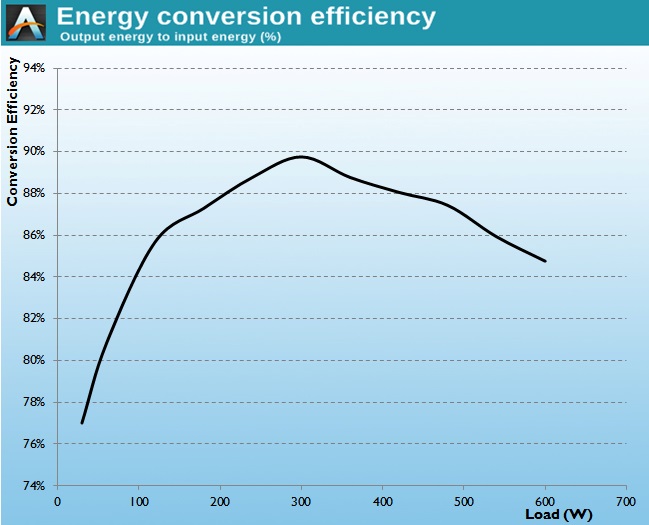
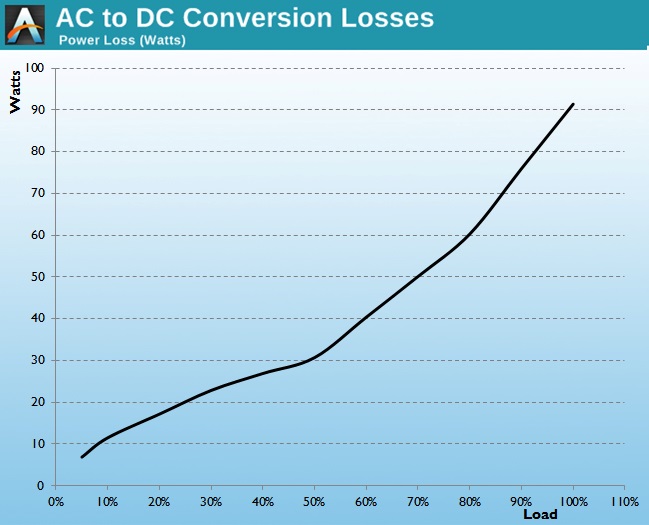
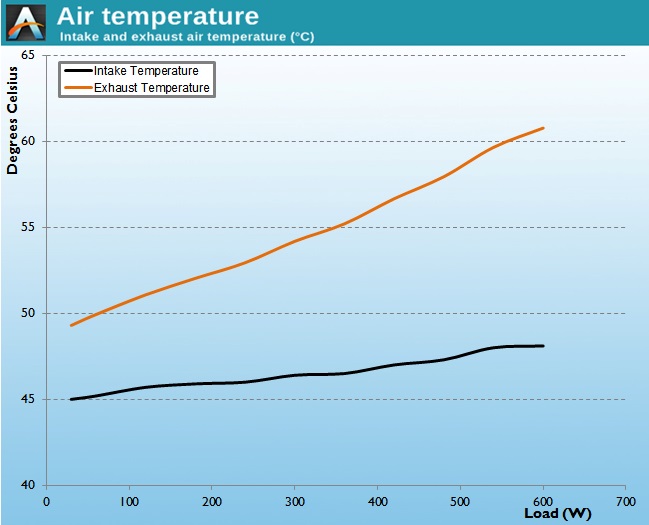
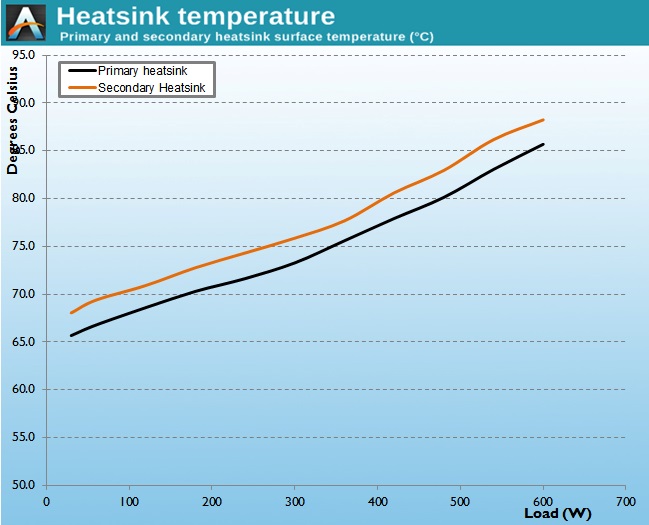
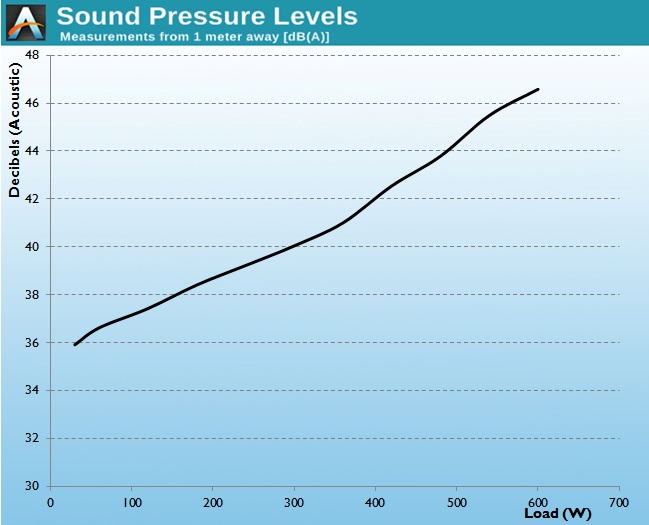








20 Comments
View All Comments
meacupla - Friday, August 21, 2015 - link
From personal experience, the SATA cables they include aren't suitable in their own cases, at least not in RVZ01.Right angle SATA connectors are completely inferior compared to straight ones inside cramped cases, because the "T", that theconnector forms with its cables, gets in the way more often than not and causes a lot of stress onto the drive connector or the cables.
The right angle SATA connectors are so bad, in fact, that I am forced to use 4-pin molex to straight SATA cables, which adds further clutter inside an already cramped case.
edzieba - Friday, August 21, 2015 - link
The downside of straight connectors is that you now need to accommodate the Minimum Bend Radius behind the drive for the cable to make a 90° turn (extra wasted space), and you need to run DOUBLE the number of actual wires through the case (due to the lack of daisy-chaining).meacupla - Friday, August 21, 2015 - link
no you don't? There are daisy-chained straight SATA connectors. This was a pretty standard type of connector found on older PSUs, but for some reason, I haven't seen many, and by that I mean none, these days.This is the perfect solution, daisy chain straight connectors: http://cdn.overclock.net/a/a8/a8f3a740_2012-12-09_...
You see, the problem with right angle connectors, is that you need accommodate the minimum bend radius between the drives anyways, because these connectors aren't spaced to the typical drive spacing.
And also, I would like to stress that 'right angle' power connectors are the 'wrong angle' in RVZ01. The 2.5" drives are belly up. The "right" angle connectors protrude above the side panel.
Margalus - Friday, August 21, 2015 - link
both types of connectors suffer from the same problems with Minimum Bend Radius, just in different situations.as for daisy chaining straight connectors, I haven't seen one with several straight connectors, I don't see how that would even be possible. The one you show just shows a single connector at the end like typical straight connectors, not several daisy chained together like you can have with the 90° cables.
not saying 90° cables are better, or that straight cables are better. they both have their uses.
geniekid - Friday, August 21, 2015 - link
More SFX/SFX-L reviews!Flunk - Friday, August 21, 2015 - link
So in summation, if you want a 600W SFX power supply you have to buy this one.About the cables, Silverstone uses the same standard for all their modular cables and has for quite a while. They offer a wide range of replacement cables in different lengths and even single cables. Not only that if you buy a bunch of their power supplies you end up with a bunch of extra cables. That's a great reason to keep buying their products. The last 4 power supplies I've bought were Silverstone, mostly so I can mix and match cables with my existing collection if I need a longer/shorter one.
meacupla - Friday, August 21, 2015 - link
Actually, Athena Power has a bunch of SFX PSUs that are over 600W and they even have an 800W model.Silverstone is also going to release a 700W model of their SST-SX500-LG, although, strictly speaking, these "Long" models don't conform to SFX standards.
Personally, I don't see how or why you would want more than 500W, because I'm quite sure you would run into thermal issues with a CPU+GPU that would require that kind of power in a case these SFX PSUs are designed to go in.
BrokenCrayons - Friday, August 21, 2015 - link
First off, thanks for reviewing power supplies of lower wattage and it's great to see Anandtech taking a look at SFX PSUs in particular. Not all of us are interested in 1000 watt supplies so the variety is great.But I did notice..."The OEM behind the *very* densely packed design you see below is Enhance. Enhance is not a *very* common manufacturer for *very* high output PSUs..." this review contained a lot of "very" and "relatively" which hurt readability somewhat.
Ryan Smith - Friday, August 21, 2015 - link
Yeah, we did go a bit overboard there. Thanks for pointing it out.ruthan - Friday, August 21, 2015 - link
2 year ago i looked for SFX PSU and only choice was Seasonic 300W and even with 30W power outcome was noise. So i moved into expensive picoPSU and after that for second very small machine i selected board with laptop like external adapter connector and adapter bundled with Akasa Euler S.Usually if you case about size, you want to have machine near of you and it means machine should be quiet.. So for smaller power consumation (<200W) machine there are better laptop like solution and for bigger machines is still ATX PSU needed.. or maybe there are some niche never where reviewed extendar passively cooler 300W boxes.. - but there are not small, so..